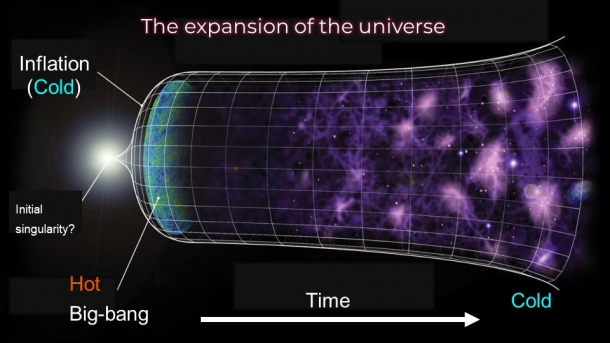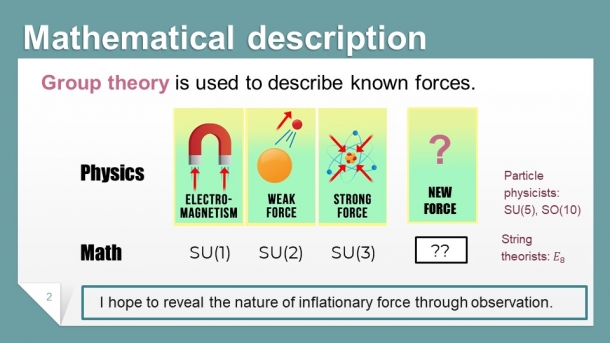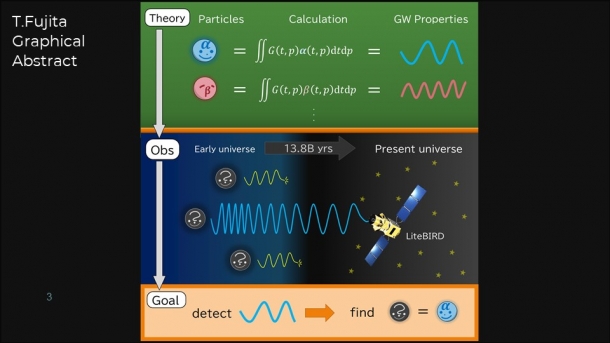
FUJITA Tomohiro, Assistant Professor
The universe began with “inflation.”
I am an astrophysicist. I am studying the beginning of the universe, which took place 13.8 billion years ago. You may have heard that the universe began with a massive explosion called the Big Bang. However, in the latest research, Inflation Theory is dominant; it holds that the universe began when accelerated expansion occurred in a physically fluctuating state where subatomic particles were repeatedly created and annihilated, breaking the law of conservation of energy and creating subatomic particles one after another. After that inflation, the universe emerged in a hot big bang as a high-temperature, high-density ball of fire. The temperature gradually decreased, and gravity eventually pulled the particles together to form stars and galaxies. Then, according to Inflation Theory, the universe took its present form (Fig. 1).

Figure 1. A diagram of the universe as it changed over time. It is believed that the universe, which was small when it was born, at some point underwent accelerated expansion (inflation), and a hot big bang (like a fireball) occurred, eventually forming the universe we know today.
My interest in space began as when I was a child, when my mother took me to a planetarium. Later, when I was in elementary school, I was given a telescope and I often looked at the night sky. It wasn’t until I was in high school, though, when I participated in an event at the National Astronomical Observatory of Japan, that I decided to study space. I was thrilled by experiences such as observing a comet in the middle of the night and analyzing the data to calculate the time when the comet’s tail would disappear, just like a real astronomer.
Looking at things in the distance to see what they used to look like
We see things thanks to the existence of light. The speed of light is so great that light can travel seven and a half times around the earth, about 300,000 km, in one second. Since light is so fast, we see things in our daily life in almost real time. However, when we look at something far away, such as a celestial body, it takes a long time for the light from that celestial body to reach us, so there is a time lag. For example, at the speed of light, the sun is about eight minutes away from the earth, so when we are looking at the sun we see it as it was eight minutes ago. Betelgeuse, the first magnitude star shining red in the constellation Orion, is 640 light years away, so we see Betelgeuse as it was 640 years ago.
It is as if we can see the past of the universe by observing parts of the universe that are far away from us. According to that theory, it seems that it is possible to see the state of the beginning of the universe. However, in fact, light can only reach us from space after the time of the formation of atoms (recombination). Before that time, light could not travel straight through the universe because it would hit electrons that were flying around—so observation of the universe before the time when atoms were formed is impossible.
A new observation tool: gravitational waves
Things changed in 2016, when gravitational waves were observed for the first time. This opened up the prospect of seeing the beginning of the universe. Gravitational waves, whose existence was predicted by Einstein 100 years ago on the basis of his general theory of relativity, are a phenomenon in which the distortion of space-time due to the gravitational effect, caused by a phenomenon such as a heavy celestial body in motion, is transmitted to its surroundings as a wave moving at the speed of light. Since gravitational waves do not interact with other objects, it is thought that gravitational waves from the beginning of the universe can reach us today.
In order to understand what the universe looked like when it was created, the LiteBIRD Satellite Project is underway in Japan. The program, aimed at observing gravitational waves (primordial gravitational waves) at the time of the beginning of the universe, is scheduled to be launched in around 2030. I am currently working to develop theory for verification of the gravitational waves observed by the LiteBIRD team.
Power is described by group theory.
Our world is governed by four forces: gravity, electromagnetism, weak force (which causes neutrons to beta-decay, i.e., changes the nature of particles), and strong force (which binds protons and neutrons together). However, when we observe the universe, we find many phenomena that cannot be explained by these four forces. Inflation is one of those phenomena: the force that caused inflation has not yet been discovered.
Of the four forces, all but gravity can be described by the gauge theory of quantum mechanics, which can be represented by group theory, a mathematical theory that can express relationships. For example, electromagnetic force is SU (1), weak force is SU (2), and strong force is SU (3). I believe that inflationary force can also be described by mathematical group theory (Fig. 2).

Figure 2. Electromagnetic, weak, and strong forces can be described by mathematical group theory as SU (1), SU (2), and SU (3), respectively. I imagine that the inflationary force can also be described by group theory.
Towards the creation of a table of the correspondence between particle properties and gravitational waves
In particle physics today, there are two types of subatomic particles: particles that constitute matter and particles that convey force. The latter particles are called the gauge bosons. For example, among gauge bosons, photons transmit electromagnetic force, weak bosons transmit weak force, and gluons transmit strong force. Gravitons, which convey gravitational force, are gravitational waves. However, it is known that when the spin (angular momentum, a property of subatomic particles) is 2, gravitons may transmit gravity, that is, there is a case in which gravitational waves are emitted. Since the gauge boson has a spin of 1, any combination of a gauge boson and a graviton could produce gravitational waves.
In that light, I am working to identify which gauge bosons are likely to generate gravity waves, apply the group theory corresponding to the force transmitted by those gauge bosons, and calculate whether or not gravity waves will be generated. If gravity waves are generated, I will work to determine the properties of those gravity waves (Fig. 3).

Figure 3. I am working on the theory component, subjecting various materials to the corresponding theories to determine what properties gravitational waves produce.
In my research so far, I have found that calculations using SU (1), which corresponds to photons (electromagnetic force), do not produce many gravitational waves, while calculations using SU (2), which corresponds to weak bosons (weak force), often produce gravitational waves. The next step will be to use SU (3), which corresponds to the gluon (strong force). By clarifying the relationship between the structure of the group, the ease of production of gravitational waves, and the nature of those gravitational waves, I aim to create a table of the correspondence between particle properties and gravitational waves.
When the LiteBird team manages to observe primordial gravitational waves, I would like use my correspondence table to clarify which particles produced the gravitational waves, and identify the particles that existed at the time of inflation. That will contribute to the elucidation of the force that caused inflation.
Interview and composition: AIMONO Keiko
In cooperation with: Waseda University Graduate School of Political Science J-School










